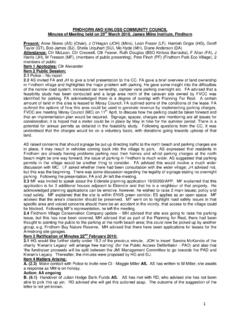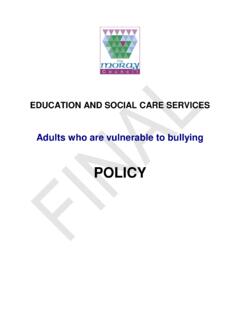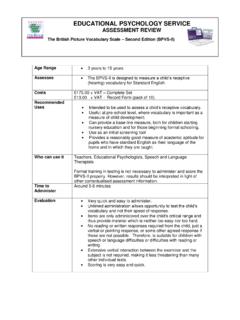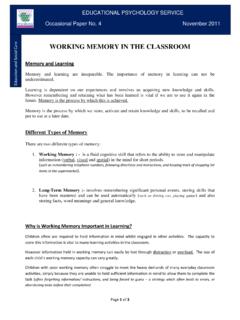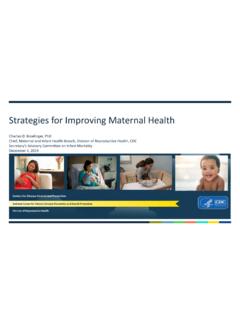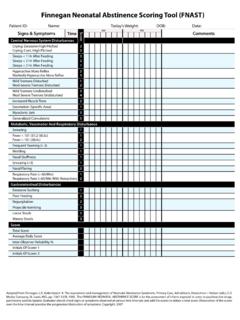Transcription of Managing Contact for Looked After Children - Moray
1 Managing Contact for Looked After ChildrenManaging Contact for Looked After ChildrenContentsForeword and acknowledgments .. 1 Introduction .. 2 Chapter 1 Bringing theory and practice together .. 5 Safe Contact .. 7 The child s needs .. 8 The child s plan .. 9 The purpose of Contact .. 10 The child s age and stage .. 11 The nature and frequency of Contact .. 12 Chapter 2 The legal framework for Contact .. 15 Relevant legislation and principles .. 16 Looked After Children s legal status and who makes the decisions .. 19 Internal reviews and external decisions .. 20 What information do decision makers need to make the best decisions?
2 21 Ten key questions for social work report writers for Children s Hearings .. 22 Decision making at the Children s Hearing .. 23 Ten key questions for Children s Hearing panel members .. 24 What to do when Contact decisions need to be reconsidered .. 25 Chapter 3 Permanence planning .. 27 Permanence processes .. 28 Making decisions about Contact in permanence planning .. 32 Preparing for a Permanence Panel .. 35 Chapter 4 Support for birth parents .. 37 When Contact starts .. 38 The child s safety .. 39 Contact Agreements .. 39 Venues .. 40 Where parents can find support .. 41 Assessing Contact .. 42 Supervising Contact .
3 43 Reviewing Contact .. 44 Keeping in touch Chapter 5 Supporting Contact : age and stage .. 47 Contact for babies and infants .. 48 Nature and frequency of Contact for babies .. 49 Contact for young Children (3 5 year olds) .. 50 Contact for Children (5 12 year olds) ..51 Contact for teenagers .. 52 Chapter 6 Supporting Contact : key relationships .. 55 Contact with siblings .. 56 Contact with grandparents and other relevant people .. 57 Chapter 7 Supporting Contact : particular needs .. 59 Babies suffering from neonatal abstinence syndrome .. 60 Contact for Children with learning disabilities .. 61 Children from ethnic minorities.
4 62 Chapter 8 Supporting Contact : Children s circumstances .. 65 Contact for permanently fostered Children .. 66 Contact arrangments for foster carers .. 68 Contact for adopted Children .. 69 Exchange of information .. 69 Support for birth parents of adopted Children .. 69 Contact arrangements for Children in kinship care .. 70 Kinship Care Assessments .. 71 Risk and resilience in kinship care .. 72 The child s views in kinship care .. 73 Siblings separated in kinship care .. 73 Chapter 9 Young people in residential care .. 75 Contact with siblings and extended family members, while in residential care .. 78 Supervision of Contact in residential care.
5 79 Reviews of Contact in residential care .. 79appendix 1 Guidelines for staff observation, support and supervision of Contact .. 82appendix 2 Normal child development 5 12 years and impact of separation and loss .. 94appendix 3 Risk and resilience .. 96appendix 4 Social Work Scotland and SCRA joint protocol on the management of Contact arrangements .. 98appendix 5 Contact for Looked After Children : rights and views .. 100appendix 6 References .. 1021 Managing Contact for Looked After ChildrenThis guidance is the product of a great deal of knowledge, experience and hard work of many people who have worked together over many months.
6 The Contact group combined the experience of practice teams, early years workers, reviewing officers, family placement workers, and residential managers to provide staff with practical guidance to support them deal with the complex challenges they face in Managing Contact . The Contact group has been consistently supported by the insights and experience of Edwina Grant, consultant psychologist and Mary McKenna, consultant social worker, as they have introduced theory and research, developed concepts and tools to ensure Contact is informed by the child s needs, is purposeful and safe and that decisions about Contact are progressed in a timely way. I am particularly grateful for the participation of Ann Chiswick, Depute Panel Chair, in helping to ensure mutual understanding in Managing Contact in LAAC Reviews and at Children s Hearings.
7 I would like to thank key people who have prepared particular chapters in the guidance, namely Alexandra Plumtree for the legal section; James Cox on Contact in kinship care; Michelle Kirkpatrick for neonatal abstinence syndrome babies, Julie Arbuckle for Children s rights; Rona Allan for Contact at LAAC Reviews and Caroline Kerr for Contact and permanence. Sally Wassell generously gave us access to her review of Research and Practice Literature on Contact , commissioned by Inverclyde, and also contributed to a training DVD which supports this guidance. We have also found the interest and feedback from CELCIS and SCRA really encouraging. Dana Lock has also been essential in making the links to other policies and materials on the ORB.
8 There has been a great deal of interest, support and feedback from practice teams, residential managers, early years workers and the disability team which has helped shape the content of the guidance. I hope this guidance will help increase confidence of all staff within the City of Edinburgh Council in planning and Managing Contact arrangements for Children in our care. Scott DunbarService Manager, Looked After and Accommodated ChildrenThe City of Edinburgh Council August 2014 Foreword and acknowledgments2 Keeping in touch IntroductionMaking arrangements for Contact between a Looked After , accommodated or adopted child and their family is a vitally important aspect of a child s plan.
9 Contact can be an intense, emotional experience for all involved parents, Children and their carers it requires planning and support to ensure that it remains safe, purposeful and positive for the child . Managing contactIn this guide we explore the range of issues that need to be considered when making decisions about Contact for Children separated from birth families. This guidance: Focuses on the child s best interest: not only their short term safety and security, but also their long term wellbeing and identity Explores how to make arrangements for Contact that take account of the needs of individual Children , their age and stage, their key relationships and their particular circumstances Highlights the need for Contact to be consistent with the child s plan and to be reviewed as the plan changes Offers a way to consider the competing rights, needs and issues of those involved in contactWho is this guide for?
10 If you are involved in making arrangements for Contact for Looked After and Accommodated Children or adopted Children at City of Edinburgh Council, the information here will help you to: Assess, support and review Contact arrangements Clearly express the purpose of Contact in reviews and at hearings Explain reasons for varying Contact arrangementsDecisions about Contact arrangements lie within other assessment processes and decision making forums, both internally and by Children s Hearings and courts. By focusing on them here we can clarify how decisions should be made, so they are more responsive to Children s needs. 2 The PuRPoSe oF CoNTACTFR equeNCY oF CoNTACT3 The NATuRe ANd1 The NeedS oF The ChIld both now and in the futureSAFeTY ANd WellBeING oF The ChIld 3 Managing Contact for Looked After ChildrenWhat s in the guide?

